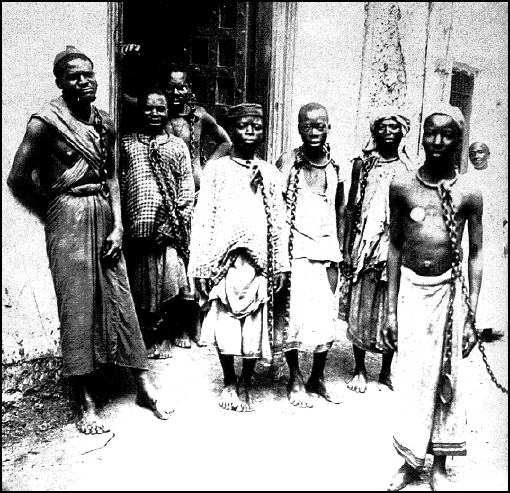
The Slave Ship
A Human History
Marcus Rediker
(Viking)

Slavery was not invented by the white Europeans, nor is it a vice peculiar to them. Everyone practiced it, wherever and whenever they could: the ancient Greeks and Romans, as well as all other ancient peoples. (The Hebrews included a provision that a man held as slave must be set free after seven years; in all other cultures, slavery was for life.)
In more modern times slavery was still ubiquitous. African blacks took their captives as slaves, and even initiated wars specifically to gather slaves, either for their own use or to sell to the white men. Arabs traded in slaves, and many of the Indian tribes of the New World kept Spanish castaways, victims of hurricanes, as slaves. In the days before we had machinery to work for us, the temptation to take a weaker ("inferior") person as a slave must have been irresistible.
--- The Scariest Place on Earth
David E. Fisher
©1994, Random HouseHistorians generally agree that by the end of the cross-Atlantic slave-trade, approximately 14,000,000 men, women and children had been abducted, but only 9,000,000 arrived in the Caribbean islands, Brazil, the United States, or elsewhere to the west. 5,000,000 died en route, during the "Middle Crossing," while being transshipped from the interior, or --- most perniciously --- while being held in anchored slave ships on the coast of Africa. The causes of death: illness, general abuse, or (quite commonly) suicide. Indeed, all slave ships were fitted with nets to keep the blacks from throwing themselves to the sharks.The main defenders of slavery were quick to use the profit-&-loss ledger as their defense. In the abolition fights in Parliament and the United States Congress during the last of the 18th Century, the argument was that "the suppression of it will destroy a great nursery for seamen, and annihilate a very comfortable source of commercial profit."
Part of the bottom line argument was that it would be foolish for the slavers to permit their charges to die, for each body transported live further augmented profit. Rediker quotes from the correspondence of the day to show that cash-flow was always at the top of the minds of the investors back in Bristol, Liverpool, Providence, or Boston: "Liverpool merchant David Tuohy wrote to Captain Henry Moore of the Blayds in 1782: 'you have a large Capital under you ... it behooves you to be very circumspect in all your proceedings, & very attentive to the minutest part of yr Conduct.'"
Some slave ships and their cargoes were worth as much as £10,000 to £12,000, which would be roughly $1.6 to $2 million in today's currency. The captain's power depended first and foremost on a connection to capitalists.

At the end of his Introduction, Rediker notes, "This has been a painful book to write, and if I have done any justice to the subject, it will be a painful book to read." He can say that again.As he lingered on the conditions of the ships and the pain and horror inflicted on men, women and children alike, this reader would flip ahead a few pages for sheer relief; to find, for example, a few pages about a theory about the true nature of the ships. They were not just there to transport bodies, the author says. They also served as a school.
At the beginning of the Middle Passage, captains hired on a motley crew of sailors who would, on the coast of Africa, become "white men." At the beginning of the Middle Passage, captains loaded on board the vessel a multiethnic collection of Africans, who would, in the American port, become "black people" or a "negro race."
"The voyage thus transformed those who made it. War making, imprisonment, and the factory production of labor power and trade all depended on violence."
There are fascinating bits here: that the sailors who did the dirty work on the vessels had a mortality rate not so much less than the blacks; that the captains, too, rarely survived more than seven voyages; that the captains and officers typically had women slaves as "favorites" during the journey, which then were sold at "'a good price' once they reached the New World;" that the cruelest captains were called "buckos;" that the ultimate weapon against the slave trade was a drawing published widely in England and the United States of hundreds of black bodies crammed together in the hold of the Brooks, one of the larger of the slave ships, along with exact measurement of the space below decks given to each body. [See Fig. 1 above].Thus the trade was not ended over a rage at the treatment of an innocent peoples, nor concern over the social and mental harm of the trade ... but by means of a communication of the profoundest feeling of simple claustrophobia.
--- Pamela Wylie